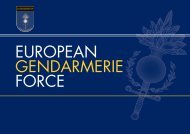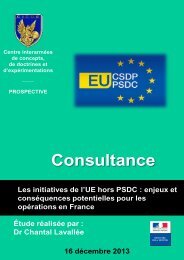Conference
science-research-bulletin-2013-conference
science-research-bulletin-2013-conference
You also want an ePaper? Increase the reach of your titles
YUMPU automatically turns print PDFs into web optimized ePapers that Google loves.
EUROPEAN POLICE SCIENCE AND RESEARCH BULLETIN<br />
SPECIAL CONFERENCE EDITION<br />
Roma Community in the Republic of Slovenia<br />
Act (2007; hereinafter: ZRomS-1), which came<br />
into force on 28 April 2007. ZRomS-1 regulates<br />
the competences of national authorities and<br />
authorities of self-governing local communities<br />
concerning the implementation of special rights<br />
of the Roma community, the organisation of the<br />
Roma community at national and local levels,<br />
and funds for financing these activities. The Act<br />
provides that the Government, in cooperation<br />
with the self-governing local communities and<br />
the Roma Community Council of the Republic of<br />
Slovenia, shall adopt a programme of measures.<br />
This programme of measures shall include<br />
relevant regulations, the obligations and tasks<br />
to be carried out by competent ministries, other<br />
national authorities, and authorities of selfgoverning<br />
local communities. With ZRomS-1,<br />
Slovenia is committed to ensure special rights of<br />
the Roma community in the fields of education,<br />
culture, employment, territorial management<br />
and environmental protection, health and<br />
social care, information and co-decision in<br />
public matters that concern members of the<br />
Roma community, implementing regulations<br />
and regulations adopted by self-managed local<br />
communities, as well as special programmes and<br />
measures adopted by national authorities and<br />
organs of self-managed local communities.<br />
Slovenia is among those European countries<br />
that include Roma in the management of public<br />
affairs at the local level. In the 20 municipalities<br />
where they have been present throughout<br />
history, members of the Roma community enjoy,<br />
in addition to the general right to vote, a special<br />
right to elect a representative to the municipal<br />
council (in 20 out of all 212 municipalities in<br />
Slovenia), to be exercised in local elections.<br />
In compliance with the legislation in force on<br />
the protection of personal data, ministries and<br />
other government bodies may not keep special<br />
records of persons based on national or ethnic<br />
affiliation, so the only demographics available<br />
are those gathered in official censuses under the<br />
auspices of the Statistical Office of the Republic<br />
of Slovenia. As the last official census in Slovenia<br />
was carried out back in 2002, the statistical<br />
data are somewhat out-dated. Due to this, we<br />
can expect some new municipalities with Roma<br />
council representatives to appear in the future<br />
(e.g. Škocjan, Brežice, Maribor).<br />
PUBLIC OPINION ON ROMA<br />
The best description of an average Slovenian’s<br />
attitude about Roma in Slovenia came recently<br />
from Tanja Fajon, European Parliament MP from<br />
Slovenia. She introduced her essay on the issue<br />
with a statement:<br />
‘We used to call Roma people ‘Gypsies’, but to<br />
my knowledge as a teenager they were nomads<br />
or were living in little ghettos; they had their<br />
own traditional culture and we did not have any<br />
close encounters with them, except that we had<br />
a great Roma singer, Oto Pesner, who conquered<br />
our hearts and the world stage. Therefore, I<br />
believed that ‘gypsies’ had a great sense for<br />
music’ (Fajon, 2011).<br />
However, as in any other place, there are many<br />
prejudices and stereotypes among the majority<br />
population about the Roma. They became<br />
even stronger in recent times of economic crisis<br />
with beliefs among non-Roma population that<br />
unemployed Roma have a better income than<br />
others who have to work hard to make a decent<br />
living. The media often add fuel to the fire; they<br />
portray Roma as being deviant and a threat to the<br />
majority population, they represent the cultural<br />
differences in a negative way, make generalisations<br />
and perpetuate stereotypes about the Roma<br />
population (Erjavec, Hrvatin & Kelbl, 2000).<br />
Roma people are also aware of the negative<br />
prejudices of the majority population. That is<br />
what is driving assimilation — the process in<br />
which a great number of the Roma people are<br />
taking the first and last names of the non-Roma<br />
people who live in the same area. A survey in<br />
Slovenia (Šuklje & Banutai, 2012) showed that<br />
many Roma change their surname due to the<br />
stigmatisation of local community, making it<br />
difficult to find the accurate statistical data on<br />
this ethnic minority. In the Prekmurje region<br />
there are scarcely any changes, as opposed to<br />
the Dolenjska region where these name changes<br />
are very common (Novak, 2012a). Reasons for<br />
these circumstances can be found in the actual<br />
state and conditions of the Roma population<br />
and its relationship to the non-Roma population.<br />
According to overall estimations, the situation<br />
is much worse in the Dolenjska and Posavska<br />
regions than in the Prekmurje region.<br />
66





